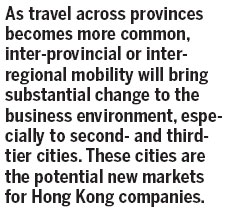High-speed rail network helping unlock markets for SMEs
Updated: 2013-03-29 06:24
By Eddy Li(HK Edition)
|
|||||||

Compared with Japan and other developed countries in Europe, China's high-speed railway construction started relatively late. Despite that, or because of it, construction began at an advanced stage. Given the accumulated experiences of other countries, the mainland avoided taking a tortuous path in its rail development. And after more than a decade of effort, China is now the No 1 operator of high-speed rail systems in the world in several categories: the highest development speed, the best integrating capability, the top operational mileage and speed, and the largest under-construction scale - this is definitely what the Chinese should be proud to see.
In the valedictory report on government performance delivered by former premier Wen Jiabao, the high-speed rail system was cited as one of the new achievements in the construction of an innovative country. I fully agree with this point. As the Beijing-Shanghai and Beijing-Guangzhou high-speed railways have become operational and other regional rail transit systems are put into operation in the near future, the national high-speed rail network will be accessible from all major cities in the country, which will not only facilitate convenient traveling for the people but have significant impact on the country's economic development.

The Beijing-Guangzhou High-Speed Railway, which is closely related to Hong Kong, was open to traffic on Dec 26, and will be linked up with the Guangzhou-Hong Kong section in the future. The whole alignment of the Guangzhou-Shenzhen-Hong Kong Express Rail Link, between its terminus at West Kowloon and Shibi in Guangzhou, is about 140 kilometers. It will connect Hong Kong, Shenzhen, Dongguan and Guangzhou. The Guangzhou-Shenzhen section was completed at the end of 2011, and the Hong Kong section is under construction and should be completed by 2015. By that time, the whole line will be open to traffic, indicating that Hong Kong will be a part of the 16,000-kilometer national high-speed railway network. By then, the public transportation system will benefit Hong Kong people a lot - the one-hour life circle within the Pearl River Delta area will be realized, and it will be so convenient to be able to arrive in major cities on the mainland, such as Changsha, Xi'an, Shanghai, Tianjin and Beijing within half a day or a day's time.
The geographical distance in China will be greatly reduced given the speed of traveling by high-speed rail. As travel across provinces becomes more common, inter-provincial or inter-regional mobility will bring substantial change to the business environment, especially to second- and third-tier cities. These cities are the potential new markets for Hong Kong companies.
In the 2013-14 Budget, the Hong Kong SAR government promised to assist Hong Kong's small- and medium-sized enterprises (SMEs) in six areas to help them raise capital and tap new markets. The Hong Kong Trade Development Council will set up more 'Design Galleries' in mainland cities to offer platforms for Hong Kong enterprises, especially SMEs, to showcase their products. SMEs can take advantage of the country's convenient high-speed rail network to break regional boundaries and tap markets in the cities along the way.
We should note that, as far as SMEs are concerned, their capital and social connections are relatively weak compared with large enterprises, so it's difficult for them to independently promote their products. Now that the HKSAR government is willing to give out funds and resources, these Hong Kong companies can seize the chance to develop in many other cities besides Beijing, Shanghai and Guangzhou.
The author is vice-president of the Chinese Manufacturers' Association of Hong Kong.
(China Daily 03/29/2013 page9)